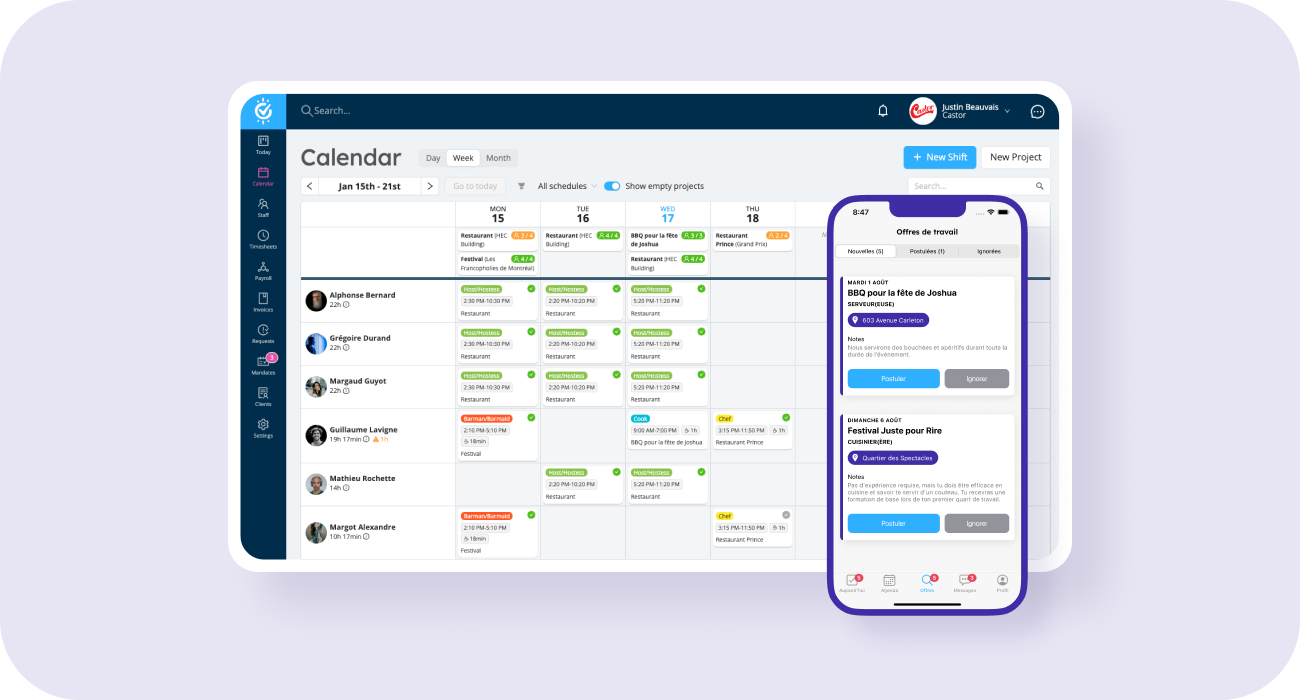Envision a workplace where employee productivity consistently reaches new heights, and satisfaction levels soar. Whether it's optimizing schedules, fostering open communication, or implementing cutting-edge staff management tools, explore actionable tips and tricks to build a successful shift management strategy.
These strategies aim to elevate your team's performance and propel your business to unprecedented success.
Key Takeaways
- Shift management is essential for a prosperous and harmonious work environment, boosting productivity and employee satisfaction.
- An efficient shift management system requires the use of technology solutions, open communication between managers and employees, as well as adaptation to unforeseen challenges such as burnout.
- Shift management software can optimize efficiency, while regular monitoring ensures that employees remain productive and engaged.

What is Shift Management?
Shift management is the strategic coordination of organizational work schedules to optimize productivity and maintain a harmonious work environment. It involves creating efficient timetables that align with business demands, ensuring adequate staffing levels during peak hours, and considering employee preferences for a balanced work-life integration.
As a shift manager, you can implement best shift management practices and leverage shift scheduling software to boost and optimize performance. Doing so can enhance your operational efficiency and promote an employee culture of well-being and productivity.
Types of Shift Schedules
Grasping the different types of shift schedules is crucial for solid management as it allows you to optimize productivity during peak hours and adapt to workload fluctuations. Implementing suitable shift schedules ensures efficient staffing and fosters engagement, contributing to operational success and cost control.
The different types of employee shift schedules include fixed, rotating, split, and on-call shifts.
- Fixed shift schedule: When the same personnel are consistently assigned to the same shift. This provides stability and routine for employees.
- Rotating shift schedules: Involves employees alternating shifts, such as working the early morning shift for six weeks, followed by the later evening shift for six weeks, offering variety and flexibility.
- Split shift schedule: Refers to a work schedule divided into two or more parts throughout the day, making it easier to schedule shifts for different employees and manage multiple shifts.
- On-call shift schedules: This type involves staff being on standby and must be readily available to come in for any last-minute replacements.
Each scheduling approach comes with its unique set of advantages and drawbacks. The choice between the different types hinges on the specific nature of your business and the varying needs of your clients and staff. As a shift manager, it is imperative to discern the scheduling types that align best with your organization's dynamics.

The Importance of Effective Shift Management
Successful workplaces thrive on effective shift management, which is a key player in boosting productivity and keeping employees happy. To break it down, let's dive into its main components.
Operational efficiency
Efficient shift management is the linchpin for optimizing resource efficiency and staff productivity. Syncing schedules with demand reduces downtime and enhances your department's overall operational effectiveness. Thoughtful shift planning becomes your shield against the headaches of understaffing or overstaffing, ensuring a seamless workflow, especially during peak business hours.
Employee Satisfaction and Well-Being
Studies show that 40% of workers are inclined to invest additional energy into their work when they sense genuine value and respect. While professional satisfaction is subjective to every individual, creating an environment of work-life balance helps cultivate higher job satisfaction and work environment. You can enhance your staff's mental and physical well-being by avoiding excessive overtime, unpredictable schedules, and constant last-minute schedule changes.
Customer Service Excellence
Providing excellent customer service isn't just about having warm bodies on hand; it hinges on having the optimal number of skilled individuals available to navigate busy periods seamlessly. The impact of understaffing or overstaffing isn't limited to customer service alone; it ripples through your entire team.
A team spread too thin finds it challenging to excel, and this strain inevitably affects their work attitude. On the flip side, a well-balanced and rested team ensures operational productivity and creates an environment that cultivates memorable experiences for your customers.
Cost Control and Budgeting
Aligning staffing levels with demand allows for the reduction of unnecessary overtime expenses. Looking ahead and conducting accurate forecasting and scheduling not only facilitates effective budget planning but also empowers your organization to allocate resources wisely, preventing financial strain and fostering long-term financial health.
Mastering effective shift management demands precise planning, accurate scheduling, and seamless coordination of your team's work schedules. However, the complexity intensifies when dealing with temporary staff, making it crucial to maintain a cooperative and effective work atmosphere for your team.
This commitment extends beyond just boosting morale; it's about crafting a workplace where everyone on your team feels seen and respected. By doing so, you're laying the foundation for a more engaged, productive, and ultimately successful workforce.

Creating an Efficient Shift Management System
Developing a shift management system tailored to your team isn't complicated, but it does call for a carefully crafted plan that can seamlessly be implemented. Here are points to consider as you establish and fine-tune your shift management system.
Scheduling Consistency
Establishing a consistent and reliable shift management system is fundamental for the smooth operation of any business relying on shift scheduling. In addition, by focusing on creating schedule consistency, you allow your team to plan their personal lives around their work schedule to create a sense of stability.
This enhances work-life balance and contributes to higher employee morale and job satisfaction, as individuals can anticipate and prepare for their work commitments, creating a more positive and harmonious workplace culture.
Allowing for Flexibility and Adaptability
On the same note, good shift management skills also mean you must be ready to handle unexpected issues smoothly. Whether your employees need to swap shifts or last-minute cancellations arise, you must have solid backup options when things don't go as planned.
An intelligent shift management strategy includes simple and clear backup plans that can be quickly implemented during emergencies. These plans outline easy steps to share the workload and keep things running smoothly, minimizing disruptions. By thinking ahead and having straightforward plans in place, you can stay on track even when faced with unexpected challenges.
Implementing Employee Scheduling Technology
Leveraging technology streamlines performance monitoring, providing real-time data for informed decision-making and facilitating agile adjustments to shift schedules. In high-risk environments such as shopping centres, construction sites or corporate campuses, security workforce management software gives managers instant visibility into who is working where and when, so they can react quickly to incidents, absences or changing risk levels. This tech-driven approach reduces scheduling conflicts, improves compliance and supports a more engaged, better-protected workforce.
Discovering the benefits of implementing staff scheduling software solutions can notably boost the effectiveness of your shift management procedures.
Embracing technology that streamlines the scheduling process offers a range of advantages, such as heightened accuracy, seamless communication, minimized scheduling conflicts, and time savings. Integrating these tools allows you to optimize shift management to create a more robust and connected workforce. This tech-driven approach enhances operational efficiency and contributes to overall employee satisfaction.
Using A Clock-In, Clock-Out Feature to Fairly Compensate Employees
Unlike full-time salaried employees, shift workers are usually paid on an hourly basis. This means you must make sure that all their hours are appropriately calculated to ensure they receive fair compensation for their time. Finding shift scheduling software that integrates a clocking in and out feature allows you to calculate hours with exact precisions.
In addition, it also enables shift managers to:
- Monitor attendance and punctuality
- Identify trends
- Keep accurate records of billable hours
- Make evidence-based decisions about staffing levels and schedule adjustments
Regularly tracking attendance and punctuality not only ensures that your workers receive fair pay for their time but also ensures a disciplined work environment, allowing timely adjustments to maintain optimal shift operations.
Using Forecasting and Analyzing Data For Optimal Efficiency
Forecasting plays a crucial role in anticipating future trends, such as predicting peak periods during the year, allowing you to navigate demand changes and resource requirements. Through accurate forecasting, you can ensure your schedules are finely tuned to meet staffing demands, creating a seamless workflow.
In conjunction, analysis dives deep into data, uncovering the strengths and weaknesses within your operations and shedding light on the areas that need improvement. Ongoing analysis becomes your compass for refining strategies, ensuring optimal scheduling efficiency.
By leveraging forecasting and analysis data, you can proactively adapt to changing staffing needs, refine strategies for optimal efficiency, and ultimately stay agile and competitive in the business scene. This strategic approach isn't just about meeting current demands; it's about future-proofing operations and maintaining a dynamic edge in the face of industry shifts and challenges.
Establishing Clear Communication Channels
Encouraging open communication and feedback helps cultivate a supportive work culture, empowering your employees to voice concerns and collaborate on creating shift schedules that cater to their needs and the business's requirements. This contributes to enhanced overall performance and well-being.
One way to keep the lines of communication open between you and your team involves using collaborative communication tools, such as shift management software with integrated mobile communication app features. While text, email, and phone calls make communication possible, the absence of follow-up and tracking can lead to misunderstandings or scheduling conflicts. Leveraging the latest technologies empowers your team members to reach out to their designated point of contact for questions or issues, ensuring a seamless and efficient process.
Establishing clear goals and KPIs
Setting clear goals and Key Performance Indicators (KPIs) provides a benchmark for employee performance, aiding in ongoing assessments and strategic shifts when needed. These goals not only serve as a roadmap for success but also empower your employees by giving them a clear understanding of expectations.
Regularly reviewing and recalibrating goals ensures that your team remains aligned with broader organizational objectives, fostering a culture of continuous improvement and adaptability to evolving business dynamics. This strategic approach contributes to a more focused, motivated, and resilient workforce.
Providing Regular Performance Evaluation and Feedback
Establishing a continuous feedback loop through regular performance evaluations is key. This practice not only allows for timely recognition of employee achievements but also pinpoints areas for improvement in shift work. It becomes a proactive strategy for you to use to identify strengths, address weaknesses, and enhance overall efficiency.
Furthermore, these regular evaluations play a crucial role in ensuring that your scheduling strategies stay aligned with evolving business needs. They provide insights into patterns, such as peak demand periods or staffing challenges, fostering the agility required to adjust strategies accordingly. Moreover, maintaining consistent feedback loops with employees contributes to a collaborative environment where their insights actively contribute to refining operational processes and enhancing overall team satisfaction.

Shift Management Challenges
Navigating the intricacies of shift management introduces various challenges that require you to take proactive solutions. Addressing these hurdles directly is essential for maintaining a harmonious and productive work environment. A few ways in which you can overcome of the most common challenges include:
Ensuring Fairness and Avoiding Favouritism
Ensuring fairness in shift scheduling is of utmost importance. As a shift manager, you must uphold impartiality and transparency, steering clear of any perception of favouritism within your team. Integrating automated scheduling tools, which objectively consider employee availability and preferences, is instrumental in minimizing potential biases and promoting an equitable allocation of shifts. This commitment to fairness not only enhances employee satisfaction but also contributes to the creation of a positive and inclusive workplace culture.
Adapting to Unforeseen Challenges
Last-minute disruptions are inevitable when it comes to shift management. However, successfully navigating these challenges is within your grasp. Developing resilient contingency plans and clear protocols is the key to efficiently handling last-minute hiccups. Keep in mind that unexpected hurdles, such as employee burnout and the imperative for fairness and equality, can substantially impact the overall effectiveness of your shift management process.
Dealing with Employee Burnout
Providing staff with regular rest and recovery periods is key to avoiding burnout and maintaining a positive work environment. By establishing limits on overtime hours and guaranteeing equitable distribution, you can ensure that your workers stay engaged and productive, contributing to the overall success of your business.
Recognizing signs of burnout and ensuring that communication channels foster open communication channels also play vital roles. Don't be afraid to encourage employees to take breaks. This promotes a healthy work-life balance, and by offering support services further demonstrate your commitment to their well-being. You want to create a workplace culture that prioritizes both productivity and employee satisfaction.

Shift Management Strategies For Boosting Temporary Employee's Morale
As discussed throughout this article, a primary focus for cultivating a productive workforce is ensuring employee satisfaction. Shift work can have both positive and negative implications on worker's morale. Whether it's a lack of flexibility or trouble reconciling personal and professional obligations that are causing your employees to lack motivation, there are strategies to follow to bolster shift workers' morale.
Strategies include:
- Providing regular breaks for employees to recharge and refocus
- Arrange team-building activities to foster a sense of camaraderie
- Align workers with company values to create a sense of purpose and belonging
- Encourage feedback to make them feel heard and valued
- Recognize and celebrate their accomplishments to boost motivation and morale.
- Monitor worker's performance to identify areas for improvement.
By keeping a close eye on performance and morale, you contribute to sustaining a work environment where employees remain engaged, productive, and satisfied, ultimately playing a key role in a company's overall success.

Enhance Your Workforce with Shift Management Software
Mastering shift management isn't just about ticking boxes; it's the key to unlocking peak workforce productivity, elevating employee satisfaction, and creating a thriving work environment. With careful consideration and implementing strategies designed to suit your team's needs, you can establish a system that benefits your employees and propels your business forward.
Incorporating advanced solutions like the Workstaff app software further refines this process. It streamlines scheduling processes, ensures seamless coordination, and empowers employees with features like schedule visibility and shift-swapping capabilities, contributing to a more flexible and efficient work environment. This strategic integration aligns seamlessly with the dynamic demands of modern workplaces, ensuring a professional yet agile approach to shift management.
Frequently Asked Questions
What is shift management?
Shift management involves scheduling team members, keeping track of their hours, and making necessary adjustments. It is an important part of running an hourly workforce.
What does a shift manager do?
As a shift manager, you're in charge of overseeing operations and assigning shifts and tasks to employees. You also work to ensure customer satisfaction and resolve any issues that may arise during your shift. You may need to adjust hours or stock inventory, as well as balance the cash register and delegate responsibilities to maintain efficiency and customer service.
How do you manage employee shifts?
To manage shifts effectively, consider the staffing levels and availability, create a list of extra shift requests, follow local rules, publish the schedule early, and communicate the rationale clearly. Ensure employees are given advance notice of changes, roles are well-defined, shifts are matched to the right staff, and there is an option for switching shifts easily. You can seamlessly manage your team using advanced staff scheduling and shift management tools.
What are the components of effective shift management?
Effective shift management involves planning, scheduling and coordinating employee work schedules to ensure an efficient workplace.
What are the different types of shift schedules?
Fixed, rotating, split and on-call shifts are the four types of shift schedules typically available for employees.










